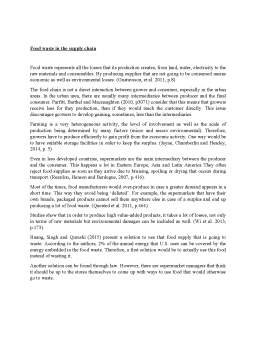Extras din referat
Abstract
The article aims to show how one of the most important industries in the world generates a chain of loss during the distribution phase. The food industry is one of the biggest industries, especially in the US. Food loss is also encountered in other countries, the main similar characteristic being the level of living in those countries. However, the reverse phenomenon happens in poor countries and it is known as food shortage. The food loss creates a chain of effect that starts with the producer and end with the consumer. Waste can be reduced as shown in the following pages.
Key words: Food waste, Environmental waste, Food distribution chain, Food ethic
Introduction
Food waste refers to the degradation in food quantity or quality in the supply chain, which makes it improper for human consumption. This concept goes from agricultural production through to processing and distribution. (Irani et al. 2017, p.2)
Food waste starts from the agricultural production and ends with the household consumption, describing the chain of food waste. In countries with higher GDP/capita, food is thrown away with a greater extent, meaning that the households and the intermediaries are responsible for most of the waste produced. Meanwhile, in the countries with lower GDP/capita the food waste The main causes are the perishability, the quality standards, the lack of planning and the poor environmental conditions during display or inadequate market facilities. (Gustavsson, et al., 2011, p.6)
Bibliografie
1 Gustavsson, J., Meybeck, A., Cederberg, C., Otterdijk, R. and Sonesson, U., (2011). Global food losses and food waste. [online] FAO. Available at: <http://www.fao.org/publications/card/en/c/I2697E> [Accessed 22 June 2018].
2 Irani, Z., Sharif, A., Lee, H., Aktas, E., Topaloğlu, Z., Wout, T. Huda, S. (3 November 2017). Managing food security through food waste and loss: Small data to big data. Computers and Operations Research, [e-journal] Available through ScienceDirect < https://www.sciencedirect.com/science/article/pii/S030505481730271X?via%3Dihub> [Accessed 22 June 2018]
3 Jayne, T., Chamberlin, J. and Headey, D. (2014). Land pressures, the evolution of farming systems, and development strategies in Africa: A synthesis. Food Policy, [e-journal] 48, pp.1-17. Available through ScienceDirect (database) <https://www.sciencedirect.com/science/article/pii/S0306919214000888> [Accessed 22 June 2018].
4 Parfitt, J., Barthel, M. and Macnaughton, S. (2010). Food waste within food supply chains: quantification and potential for change to 2050. Philosophical Transactions of the Royal Society B: Biological Sciences, [e-journal] 365(1554), pp.3065-3081. Available through JSTOR (database) < https://www.jstor.org/stable/20752997?seq=1#page_scan_tab_contents> [Accessed 22 June 2018].
5 Quested, T., Parry, A., Easteal, S. and Swannell, R. (2011). Food and drink waste from households in the UK. Nutrition Bulletin, [e-journal] 36(4), pp.460-467. Available through Wiley Online Library <https://onlinelibrary.wiley.com/doi/full/10.1111/j.1467-3010.2011.01924.x> [Accessed 22 June 2018].
6 Reardon, T., Henson, S. and Berdegue, J. (2007). Proactive fast-tracking' diffusion of supermarkets in developing countries: implications for market institutions and trade. Journal of Economic Geography, [e-journal] 7(4), pp.399-431. Available through OxfordAcademic (database) <https://academic.oup.com/joeg/article-abstract/7/4/399/888280> [Accessed 22 June 2018].
7 Wi, S., Choi, I., Kim, K., Kim, H. and Bae, H. (2013). Bioethanol production from rice straw by popping pretreatment. Biotechnology for Biofuels, [e-journal] 6(1), p.166-178. Available through US National Library of Medicine National Institutes of Health <https://www.ncbi.nlm.nih.gov/pmc/articles/PMC4176758/> [Accessed 22 June 2018].
8 Huang, H. B., Singh, V., Qureshi, N., (15 September 2015). Butanol production from food waste: a novel process for producing sustainable energy and reducing environmental pollution. Biotechnology for Biofuels, [e-journal] 8(147), Available through CABDirect < https://www.cabdirect.org/cabdirect/abstract/20153332083 > [Accessed 22 June 2018]
Preview document
Conținut arhivă zip
- Food Waste in the Distribution Chain.docx








